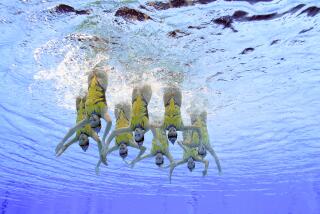Keeping Jr. Afloat : Best Pool Rule: Never Look Away
- Share via
COSTA MESA — Angel Watts of Santa Ana Heights put her child into the water Thursday to make sure that he stays out of trouble in the water in the future.
Watts, 22, and her 13-month-old son, Jared, were among the participants in a year-old program run by the Orange County chapter of the American Red Cross, which is trying to combat incidents of drowning, the highest cause of death among children under 3 in California.
“It’s very important, especially for kids a little older than mine because they’re harder to keep track of and more curious about the water,” Watts said. “You can’t let them get out of your sight for a second.”
The Red Cross’s infant and preschool aquatic program, called “Parent and Me,” aims at familiarizing children more than 6 months old with water and teaching them survival skills. It also instructs parents to be especially vigilant when their children are around pools and at the beach.
Last year, 11 children drowned in Orange County. So far in 1991, five have drowned and 50 have been hospitalized in near-drowning incidents. This July--the month in which most child drowning deaths usually occur--Red Cross officials are encouraging parents, especially those with pools, to enroll their young children in water-familiarization classes.
“Rather than keeping kids in Orange County out of the pool, we’d rather have them in the pool and learning something,” said Marsha Felton, the Orange County Red Cross associate director of health and safety.
During a class at the downtown community center in Costa Mesa on Thursday morning, six parents sang songs as they bobbed their children in and out of the water. Most of the children, ages 6 to 18 months, clearly enjoyed themselves, slapping the water and grinning as parents taught them how to blow bubbles and crawl out of the pool.
Red Cross spokeswoman Judy Iannaccone emphasized that the two-week course is not intended to “drown-proof” children, but she noted that it does teach skills that complement other safety measures and could eventually save a child’s life.
The life-saving classes aim at making parents aware of the importance of closely monitoring children near pools. “Half the battle is raising the awareness of the parents. It only takes a few moments for an infant to drown,” Iannaccone said.
The Red Cross program is gaining popularity among parents in the county, but the American Academy of Pediatrics, a Chicago-based organization which represents 37,000 doctors, warns that children younger than 3 are never safe without supervision around pools and other swimming areas.
“We don’t think children under the age of 3 can be made ‘water safe,’ ” said William Boyle, chairman of the AAP’s committee on poisoning and injury prevention, in a telephone interview Thursday. “There’s no doubt that they can be taught to swim, but there’s no evidence that it has survival value.”
Although the Red Cross program follows the guidelines set by the AAP and does not promise to make children “drown-proof,” Boyle said parents may be lulled into thinking that their children with such training are safe around water.
“I think that that’s a fear,” he said. “I think (parents) will be less vigilant (if the child has water training).”
Instructor Anne James, who teaches the class with the help of her 5-year-old daughter, Meaghan, said she agrees that “that’s a good fear.”
“Most children (don’t have) the skills they need to swim unsupervised until they’re 7,” James said. “You have to be very careful--the child may think they’re competent enough, the parent may think they’re competent enough, but they’re not until they’re older.”
James also said that the training is important and that parents, especially those with pools, should not fail to get their children into classes.
The father and five mothers who attended the class with their children on Thursday agreed that it would improve their children’s safety in the water.
“It’s important for me for them to be pool-safe, not necessarily to be expert swimmers, but to be safe in the water,” said Andre Ingram, 30, of Costa Mesa. By taking the class with his daughter, he said, “I’m trying to cut down the risk factor as much as I can.”
“When I was a child, my main problem was being scared (of the water), of being pushed in and panicking,” Ingram said. “They (children) shouldn’t be afraid of the water. There’s lots of fun with being in the water.”
Preventing Tragedy More children drown in July than in any other month, usually in incidents involving pools. Here are some suggestions for preventing such accidents: Fences: Enclose the pool area completely with a high fence that children cannot climb or slip through. A height of 4 to 5 feet is recommended. Gates: Fence gates should be self-closing and self-latching. The gate latch should be beyond a child’s reach. Pool covers: Covers should attach securely around the pool’s perimeter and be strong enough to support the weight of two adults. Don’t allow water to accumulate on top of the cover. Steps: Remove steps leading to above-ground pools when they are not in use. Perparedness: Parents should learn cardiopulmonary resuscitation. Children should have water safety or swimming lessons. Keep a phone in the pool area, along with a life ring and hooked pole. Awareness: Keep an eye on children when they are around water. Almost 70% of child drownings occur when parents are momentarily distracted. Source: American Red Cross and Los Angeles Times
More to Read
Sign up for Essential California
The most important California stories and recommendations in your inbox every morning.
You may occasionally receive promotional content from the Los Angeles Times.










